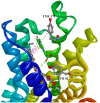Identification of Candidate Allosteric Modulators of the M1 Muscarinic Acetylcholine Receptor Which May Improve Vagus Nerve Stimulation in Chronic Tinnitus
- PMID: 29184482
- PMCID: PMC5694542
- DOI: 10.3389/fnins.2017.00636
Identification of Candidate Allosteric Modulators of the M1 Muscarinic Acetylcholine Receptor Which May Improve Vagus Nerve Stimulation in Chronic Tinnitus
Abstract
Chronic tinnitus is characterized by neuroplastic changes of the auditory cortex. A promising method for therapy of chronic tinnitus is vagus nerve stimulation (VNS) combined with auditory stimulation. The principle of VNS is reversal of pathological neuroplastic changes of the auditory cortex toward physiological neural activity and synchronicity. The VNS mechanism of action in chronic tinnitus patients is prevailingly through the muscarinic neuromodulation of the auditory cortex by the activation of nc. basalis Meynerti. The aim of this study is to propose potential pharmaceutics which may improve the neuromodulatory effects of VNS. The working hypothesis is that M1 receptors have a dominant role in the neural plasticity of the auditory cortex. We propose that allosteric agonists of the muscarinic receptor type 1 (M1) receptor could improve specificity and selectivity of the neuromodulatory effect of VNS on the auditory cortex of chronic tinnitus patients even in the circumstances of lower acetylcholine brain concentration. This intervention would also reinforce the re-learning process of tinnitus (sub)networks by acting on cholinergic memory and learning mechanisms. We performed in silico screening of drug space using the EIIP/AQVN filter and selected 50 drugs as candidates for allosteric modulators of muscarinic receptors. Further filtering of these compounds by means of 3D QSAR and docking revealed 3 approved drugs-bromazepam, estazolam and flumazenil as the most promising candidates for combined chronic tinnitus therapy. These drugs should be further evaluated by biological tests and clinical trials.
Keywords: M1 receptor; in silico analysis; information spectrum method; muscarinic allosteric agonists; tinnitus; vagus nerve stimulation.
Figures




Similar articles
-
In Silico Study in MPO and Molecular Docking of the Synthetic Drynaran Analogues Against the Chronic Tinnitus: Modulation of the M1 Muscarinic Acetylcholine Receptor.Mol Biotechnol. 2024 Feb;66(2):254-269. doi: 10.1007/s12033-023-00748-5. Epub 2023 Apr 20. Mol Biotechnol. 2024. PMID: 37079267
-
Directing neural plasticity to understand and treat tinnitus.Hear Res. 2013 Jan;295:58-66. doi: 10.1016/j.heares.2012.10.001. Epub 2012 Oct 23. Hear Res. 2013. PMID: 23099209 Review.
-
Vagus nerve stimulation modulates cortical synchrony and excitability through the activation of muscarinic receptors.Neuroscience. 2011 Aug 25;189:207-14. doi: 10.1016/j.neuroscience.2011.05.024. Epub 2011 May 26. Neuroscience. 2011. PMID: 21627982
-
Pairing sound with vagus nerve stimulation modulates cortical synchrony and phase coherence in tinnitus: An exploratory retrospective study.Sci Rep. 2017 Dec 11;7(1):17345. doi: 10.1038/s41598-017-17750-y. Sci Rep. 2017. PMID: 29230011 Free PMC article.
-
Direct and Transcutaneous Vagus Nerve Stimulation for Treatment of Tinnitus: A Scoping Review.Front Neurosci. 2021 May 28;15:680590. doi: 10.3389/fnins.2021.680590. eCollection 2021. Front Neurosci. 2021. PMID: 34122002 Free PMC article.
Cited by
-
S3 Guideline: Chronic Tinnitus : German Society for Otorhinolaryngology, Head and Neck Surgery e. V. (DGHNO-KHC).HNO. 2022 Nov;70(11):795-827. doi: 10.1007/s00106-022-01207-4. Epub 2022 Oct 13. HNO. 2022. PMID: 36227338 Free PMC article. Review. No abstract available.
-
Neuroprotective Effect of Valproic Acid on Salicylate-Induced Tinnitus.Int J Mol Sci. 2021 Dec 21;23(1):23. doi: 10.3390/ijms23010023. Int J Mol Sci. 2021. PMID: 35008469 Free PMC article.
-
In Silico Study in MPO and Molecular Docking of the Synthetic Drynaran Analogues Against the Chronic Tinnitus: Modulation of the M1 Muscarinic Acetylcholine Receptor.Mol Biotechnol. 2024 Feb;66(2):254-269. doi: 10.1007/s12033-023-00748-5. Epub 2023 Apr 20. Mol Biotechnol. 2024. PMID: 37079267
-
Cholinergic Hypofunction in Presbycusis-Related Tinnitus With Cognitive Function Impairment: Emerging Hypotheses.Front Aging Neurosci. 2018 Apr 6;10:98. doi: 10.3389/fnagi.2018.00098. eCollection 2018. Front Aging Neurosci. 2018. PMID: 29681847 Free PMC article.
-
Pathophysiology of Subjective Tinnitus: Triggers and Maintenance.Front Neurosci. 2018 Nov 27;12:866. doi: 10.3389/fnins.2018.00866. eCollection 2018. Front Neurosci. 2018. PMID: 30538616 Free PMC article. Review.
References
-
- Bojić T. (2003). Mechanisms Of Cardiovascular Control And Effects Of Acoustic Stimulation On Cardiovascular System During The Wake-Sleep Cycle. Ph.D. Dissertation, Alma Mater Università di Bologna.
LinkOut - more resources
Full Text Sources
Other Literature Sources

